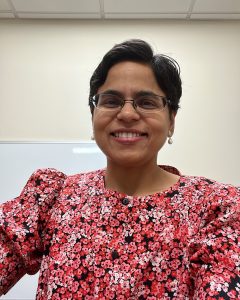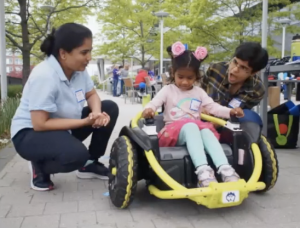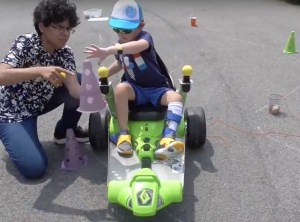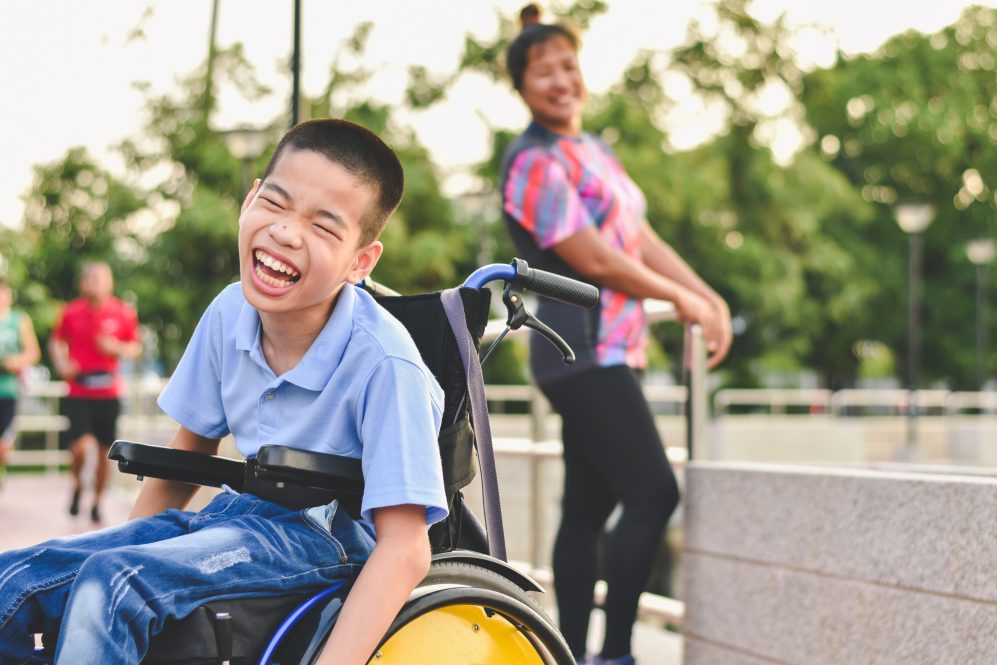From a young age, children learn about and engage with their environment through touch, whether they are playing, experimenting, or exploring. Play supports a child’s physical, cognitive, and social development, but children with disabilities may face challenges participating in play.
These obstacles, which can be physical or cognitive, may inhibit a child’s desire to partake in more complex tasks. These lost opportunities for movement at an early age could impact the motor, social, and emotional development of children with disabilities.

Motivation is the single most influential factor unrelated to a child’s diagnosis that shapes changes in motor skills, function, and potentially also neural reorganization following movement-based interventions in children with cerebral palsy, says Sudha Srinivasan, assistant professor in the Department of Kinesiology in the College of Agriculture, Health, and Natural Resources and principal investigator at the Institute for Collaboration on Health, Intervention, and Policy (InCHIP).
Srinivasan leads the Rehabilitation Innovations & Emerging Novel Technology in Physical Therapy (REINVENT-PT) Lab, which investigates how the developmental paths of infants and children with neuro-developmental disabilities compare to typically developing peers to create empowering and engaging evidence-based, child-friendly and playful behavioral interventions and assistive technologies.
Among the projects that Srinivasan is leading in the REINVENT-PT Lab is one that evaluates the use of joystick-operated, ride-on-toys to improve arm use and motor function in children diagnosed with cerebral palsy, the most common childhood-onset motor disability. She is working with children with hemiplegic cerebral palsy, a type of motor disability that affects function on one side of the body due to damage to brain structures that control movements on that side. About 40% of children with cerebral palsy have hemiplegia. Children with hemiplegia often have difficulty controlling movements on one side, which may limit their ability to move their hand and arm to interact with their environment and engage in daily activities. Early and effective movement training has been found to improve motor function and outcomes for children with hemiplegia.
“Compared to neurotypical peers, children with cerebral palsy have lower motivation and are reluctant to try complex, challenging tasks during play. A child’s lack of motivation can limit their willingness to engage in therapeutic activities with the necessary frequency and intensity necessary to make functional gains,” says Srinivasan.
While contemporary approaches to improve upper extremity function on the affected side are effective, they rely on intense, repetitive practice, which can be time-consuming and monotonous for children. As a result, children with hemiplegia may not practice assigned functional tasks with the frequency and intensity needed for them to make gains.
To keep children motivated and adhere to programming, therapists must create activities and environments that are stimulating, fun, challenging, and intrinsically motivating. Other barriers to successful treatment include time, cost, availability, and accessibility of therapy/rehabilitation services.

Joystick-operated, ride-on-toy navigation training is one solution that could help families overcome these barriers while also keeping children engaged.
“Given the continual challenges faced by clinicians to maintain children’s motivation during therapy and ensure repetitive upper extremity practice to induce functional changes, commercially available joystick-operated ride-on-toy technologies can be adapted and incorporated into home programs to serve as innovative, child-friendly solutions to boost self-initiated use of the upper extremity in children with impaired arm function,” says Srinivasan.
While ride-on-toys have been found to help improve movement, social skills, and participation in activities for children who are non-ambulatory, how these tools may improve upper extremity mobility has not been studied. Srinivasan’s project is the first to evaluate the use of joystick-operated ride-on-toys as an intervention to improve upper limb use and function in children who have hemiplegic cerebral palsy.
Through start-up funds from the Office of the Vice President of Research, Srinivasan led a pilot study that evaluated the implementation and effectiveness of using joystick-operated ride-on-toys during the Lefty and Righty Camp, a 3-week Waterbury-based annual summer camp for children with hemiplegic cerebral palsy.

Over the duration of the camp, children were encouraged to use their affected side throughout the day during activities and games, as well as functional self-care tasks like eating. Ride-on toy navigation training was one of the daily camp activities, which encouraged the use of children’s affected arm to navigate through obstacle courses and scavenger hunts.
The team found that the training improved participants’ navigation accuracy, and children, clinicians, and caregivers reported that the goal-oriented training was fun and built confidence in children. Around 90% of caregivers and 75% of clinicians reported improvements in children’s arm function, and 100% of children wanted to repeat the training with the ride-on-toys.
Based on the data, Srinivasan and her team secured a pilot grant through the National Institutes of Health (NIH) and the American Academy of Cerebral Palsy and Developmental Medicine (AACPDM) for the second study to evaluate the efficacy of a home-based joystick-operated ride-on-toy navigation training program for children with hemiplegic cerebral palsy.
The study is funded through the National Pediatric Rehabilitation Resource Center (C-PROGRESS), the National Institute for Biomedical Imaging and Bioengineering, the National Institute for Neurological Disorders and Stroke, and the Eunice Kennedy Shriver National Institute of Child Health and Human Development.
The study aims to design a child- and family-centric intervention that can be easily implemented by caregivers and can supplement conventional therapy. It would also address accessibility issues related to therapist availability, and time and financial constraints.
Based on data from the previous studies, Srinivasan and her team expect that the ride-on-toy navigation training program will be acceptable to families, feasible to implement for families and researchers, and associated with high rates of treatment adherence as well as high engagement from children throughout the intervention phase.
“By expanding hours of therapy beyond clinic/school settings, involving caregivers as interventionists, and increasing goal-oriented practice as part of children’s play routines in their naturalistic environments, we aim to improve arm function and independence while reducing future complications of non-use/disuse in children with hemiplegia,” says Srinivasan.



